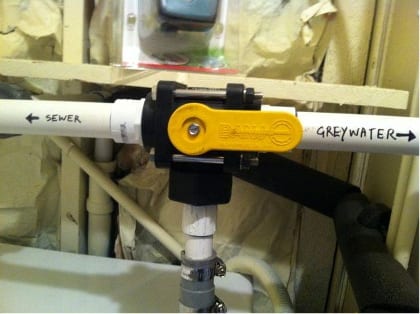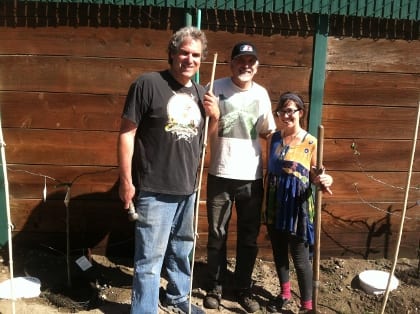by Ken Foster
It is called “greywater” for a reason, and whether you spell it greywater or graywater obviously it is not one of those black and white solutions to water conservation. It’s, well…murky. Regardless of the spelling it’s one of the best strategies for maximizing your water economy. The new word “watergy” refers to all the energy we spend making water potable and transporting it around. In the State of California 20% of our overall energy is used for this purpose. So using greywater eases your water budget, reduces watergy, and conserves the water itself when you keep it on your site.

Greywater regulations in a few states allow use of greywater to irrigate plants such as this apple tree in California.
Technically, greywater is all used house water sources including bathtub, shower, bathroom sinks and laundry, conversely blackwater refers to toilet and kitchen sink water. The easiest to install is a “laundry to landscape” greywater system. This type of system diverts the laundry wash water from going to the sewer or septic and sends it into multiple ‘mulch basins’ where it infiltrates safely into the ground to irrigate the root zone of garden and landscape plants. Because the water leaves the house grey, storing it can quickly result in a science experiment as the greywater becomes blackwater. For this reason storing greywater is not recommended.
Many cities did not have a legal distinction between greywater and blackwater water until recently. This meant many domestic reclamation efforts were technically illegal. With increased concerns over droughts and water shortages many citizens advocate for easing laws to allow for the use of greywater.
Former California governor Arnold Schwarzenegger signed into the plumbing code legal use of greywater in 2007. Guidelines now make it clear how to install a safe greywater system, and as long as the house plumbing is not altered no permit is required. No deaths have ever been reported from the use of greywater, but to be safe from any possible contamination, above-ground pooling is ruled out with these guidelines.
Greywater Laws Differ by State
Some states have more restrictions than others. Almost all states have required households to dispose of used water through the sewer system. Georgia, for instance, retains the antiquated status quo, requiring all used water to be filtered and treated like sewage. Homeowners who want to use greywater – water from baths, showers, and laundry – have to install a complete treatment system.
Since the U.S. Environmental Protection Agency endorsed greywater use as a way to conserve fresh water, some states have moved to ease their laws and allow greywater to be channeled to landscaping and toilets. Some states – Texas, California, and New Mexico – encourage responsible greywater use in order to alleviate water shortages in drought-prone regions. An added benefit is a reduction in the amounts of chemicals being used to treat wastewater.
Installation Basics
The laundry out-flow water is diverted with a three way valve installed right next to the washing machine. This gives you the option of diverting the water back to the sewer or septic if needed for any reason. Some examples might be if bleach is going to be used in a load or if the ground is already saturated from rainwater.
Next: it is important to install an “anti-siphon” or “backflow prevention vent” that will disallow the greywater from siphoning back into the washing machine. This vent should be six inches above the washing machine’s high water mark.

A correctly installed air admittance valve prevents greywater from siphoning back into the washing machine.
The greywater flows out to the landscape through one-inch poly tubing where it is dispersed at multiple ‘mulch basins’. The number of mulch basins depends on what size the wash load is and how many loads are done per week. Between 5 and 10 mulch basins is typical. A mulch basin is simply a 2 foot x 2 foot hole dug in the soil and filled with wood chips. Each mulch basin has a manual shut off valve so you can make the call where the water is dispersed.
To make the greywater friendly to plant and tree roots it is important to only use laundry soaps that have no chlorine bleach, dyes, or chemical scents that can be harmful to plants. Examples of ‘greywater’ friendly laundry soaps are Oasis Laundry Detergent (liquid), ECOS liquid detergent, Vaska, and Dr. Bronners liquid soap. Vaska also makes a commercial laundry detergent that is compatible with commercial washing machines.
Finally it is advised that greywater not be used directly on leaf vegetables, root crops, or grass for that matter. A mulch basin near the root zone of a fruit tree is a good example of the best use of greywater. As you reduce water consumption, using a greywater system allows you to water even as you mind landscape water restrictions.
I hope this clarifies your greywater (questions).
Resources on Greywater
http://www.greywateralliance.org/: The Greywater Alliance
http://oasisdesign.net/greywater/: Grey Water Central
https://www.whollyh2o.org/graywater/item/353-graywater-codes-and-regulations.html
www.whollyh2o.org: Mainstreaming localized water (re)Use
http://www.ewg.org/: The Environmental Working Group
About the Author
Ken Foster served as an apprentice at the U.C. Santa Cruz Farm and Garden and has a certificate in Ecological Horticulture from there. He has an A.S. degree in horticulture from Cabrillo College. He has owned and operated Terra Nova Ecological Landscaping since 1988 and is a certified permaculture contractor and landscape contractor. Through March 2014, Terra Nova Ecological landscaping offers free estimates for a “Laundry to Landscape” greywater system along with $50.00 off installation. Ken may be reached at ken@terranovalandscaping.com.




